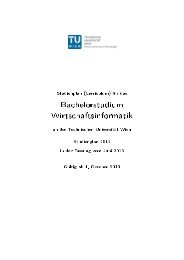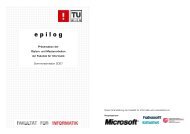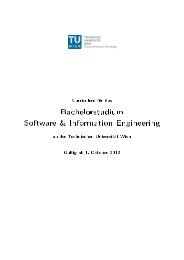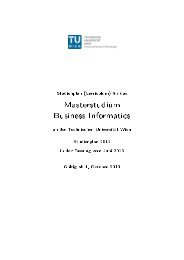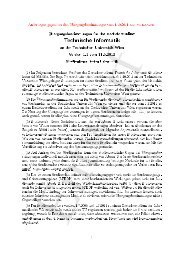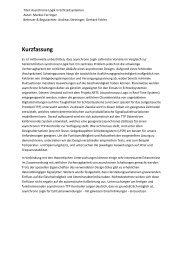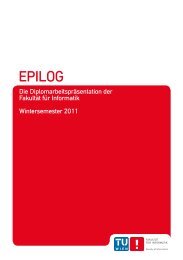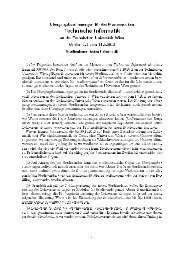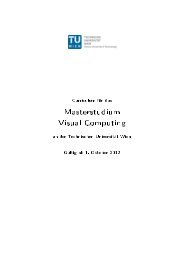Abstract-Band - Fakultät für Informatik, TU Wien - Technische ...
Abstract-Band - Fakultät für Informatik, TU Wien - Technische ...
Abstract-Band - Fakultät für Informatik, TU Wien - Technische ...
Sie wollen auch ein ePaper? Erhöhen Sie die Reichweite Ihrer Titel.
YUMPU macht aus Druck-PDFs automatisch weboptimierte ePaper, die Google liebt.
sich als geeignet herausgestellt. Dabei wird ein Bild durch die Häufigkeiten<br />
seiner enthaltenen visuellen Worte beschrieben. Diese visuellen Worte werden<br />
von lokalen Bildmerkmalen abgeleitet. Methoden auf dem aktuellen Stand der<br />
Wissenschaft verwenden SIFT Merkmale, welche den Nachteil einer aufwendigen<br />
Berechnung haben. Um dem entgegenzuwirken werden in dieser<br />
Arbeit SIFT Merkmale durch binäre Merkmale ersetzt. Binäre Merkmale bestehen<br />
aus einer einfachen Liste an Bits und ermöglichen bestimmte Schritte der Bags<br />
of Visual Words Methode effizienter durchzuführen. Das Erzeugen der visuellen<br />
Worte ist einer dieser Schritte und äußerst zeitaufwändig. Ein alternativer<br />
Clustering-Algorithmus, kShifts, wird untersucht, um diesen Schritt effizienter<br />
durchzuführen. Weiters wird der kMeans Algorithmus <strong>für</strong> binäre Merkmale<br />
angepasst und mit kShifts verglichen. Für die Evaluierung des vorgestellten<br />
Systems werden frei verfügbare Bilddatenbanken verwendet. Ein Vergleich mit<br />
aktuellen Methoden wird gezogen. Zusätzlich wird eine Bilddatenbank mit circa<br />
1,000,000 Pressebildern als praxisorientierter Anwendungsfall untersucht.<br />
Christopher Pramerdorfer<br />
Depth Data Analysis for Fall Detection<br />
Studium: Masterstudium Visual Computing<br />
BetreuerIn: Privatdoz. Dr. Martin Kampel<br />
Falls are a leading cause for accidental deaths among persons aged 65 or<br />
older. Fall victims require immediate assistance in order to minimize morbidity<br />
and mortality rates. However, statistically every other fall victim is unable to get<br />
back up without help. The aim of fall detection is to ensure fast assistance by<br />
automatically informing caretakers in case of falls. Different methods have<br />
been proposed for this purpose, but there are still unresolved issues that limit<br />
the applicability of fall detection systems in practice. This thesis introduces a<br />
new fall detection system using current depth-sensing technology, with the<br />
aim of addressing these limitations. This sensor technology has several<br />
advantages over alternatives; it is unobtrusive, preserves the privacy of subjects,<br />
and works independently of lighting conditions, allowing for continuous<br />
monitoring. The generated data enables powerful scene analysis and,<br />
consequently, reliable fall detection. The applicability of this technology is<br />
verified by means of a quantitative analysis, in order to assess its limitations<br />
and data quality. In contrast to existing methods, the proposed system<br />
emphasizes person detection and tracking, which allows for robust temporal<br />
analysis and thus improves fall detection performance. To this end, this work<br />
also proposes a new motion detection algorithm optimized for depth data and<br />
fall detection. Furthermore, this work contributes to the research field of<br />
tracking by introducing effective means for tracking multiple persons. The<br />
proposed system is easy to set up, plug and play, and can run on inexpensive<br />
low-end hardware, promoting broad acceptance. This work shows that reliable<br />
fall detection in depth data is possible, as verified on a comprehensive fall<br />
database. At the time of writing, the system is tested under practical conditions<br />
in four countries, with promising first results.<br />
26



